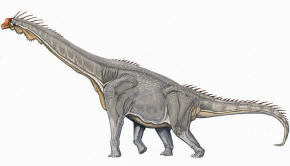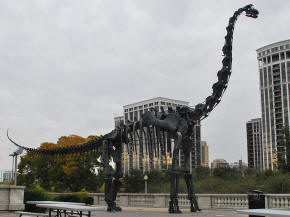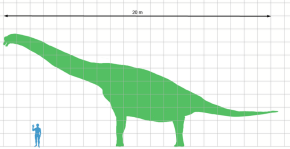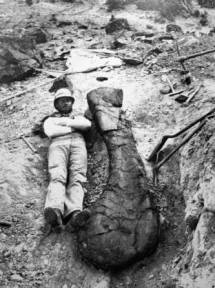correspondence between Riggs and S. M. Bradbury, a dentist in
nearby
Grand Junction. In 1899 Riggs had sent inquiries to rural locations in
the western United States concerning fossil finds, and Bradbury, an amateur
collector himself, reported that dinosaur bones had been collected in the
area since 1885. It was Riggs' field assistant H. W. Menke who found FMNH P
25107, on July 4, 1900. The locality, Riggs Quarry 13, was found on a small
hill later known as Riggs Hill; it is marked by a plaque. Additional
Brachiosaurus fossils are reported on Riggs Hill, but other fossil finds
on the hill have been vandalized. Riggs published a short report in 1901,
noting the unusual length of the humerus compared to the femur and the
extreme overall size and the resulting giraffe-like proportions, as well as
the lesser development of the tail, but did not publish a name for the new
dinosaur. The titles of Riggs (1901) and (1903) suggested that the specimen
was the largest known dinosaur. Riggs followed his 1903 publication that
named Brachiosaurus altithorax with a more detailed description in a
monograph
in 1904.
The Fruita skeleton was not the first discovery of
Brachiosaurus
bones, although it was the first to be recognized as belonging to a new and
distinct animal. In 1883, a sauropod skull was found near
Garden Park, Colorado, at Felch Quarry 1, and was sent to
Othniel Charles Marsh (of "Bone
Wars" fame). Marsh incorporated the skull into his skeletal restoration
of "Brontosaurus" (now
Apatosaurus). It eventually became part of the collections of the
National Museum of Natural History, as USNM 5730.
Additional discoveries of
Brachiosaurus material in North America
have been uncommon and consist of a handful of bones. Material has been
described from Colorado, Oklahoma, Utah, and Wyoming, and undescribed
material has been mentioned from several other sites.
Etymology
Riggs derived the genus name from the
Greek
brachion/βραχιων meaning "arm" and
sauros/σαυρος
meaning "lizard", because he realized that the length of the arms was
unusual for a sauropod. The species epithet "altithorax" was chosen because
of the unusually deep and wide chest cavity, from
Latin
altus meaning "deep" and Greek
thorax/θώραξ (Latin
thorax),
meaning "breastplate, cuirass, corslet".
Species -
Brachiosaurus
altithorax
FMNH P 25107, the
holotype
of both the genus Brachiosaurus and the species
B. altithorax,
consists of the right humerus (upper arm bone), the right femur (thigh
bone), the right
ilium (a hip bone), the right coracoid (a shoulder bone), the sacrum
(fused vertebrae of the hip), the last seven thoracic (trunk) and two caudal
(tail)
vertebrae, and a number of ribs.
Riggs described the coracoid as from the left side of the body,
but restudy has shown it to be a right coracoid.
Paleoecology
With the removal of the East African
Giraffatitan,
Brachiosaurus is known only from the
Morrison Formation of western North America. The Morrison Formation is
interpreted as a
semiarid environment with distinct
wet
and dry
seasons, and flat
floodplains. Vegetation varied from
gallery forests (river–lining forests in otherwise treeless settings) of
conifers,
tree ferns, and
ferns, to fern
savannas
with rare
Araucaria-like
trees. Several other sauropod genera were present in the Morrison Formation,
with differing body proportions and feeding adaptations. Among these were
Apatosaurus,
Barosaurus,
Camarasaurus,
Diplodocus,
Haplocanthosaurus, and
Supersaurus.
Brachiosaurus was one of the less abundant
Morrison Formation sauropods. In a survey of over 200 fossil localities,
John Foster reported 12 specimens of the genus, comparable to
Barosaurus
(13) and Haplocanthosaurus (12), but far fewer than
Apatosaurus
(112), Camarasaurus (179), and
Diplodocus (98).
Brachiosaurus fossils are found only in the lower-middle part of the
expansive Morrison Formation (stratigraphic zones 2-4), dated to about
154-153 million years ago, unlike many other types of sauropod which have
been found throughout the formation.
Paleobiology
Neck position
In contrast to most other sauropods, brachiosaurids had an inclined back,
due to their long forelimbs. Therefore, if the neck exited the body in a
straight line, it already pointed upwards. The exact angle is influenced by
how the pectoral girdle is reconstructed, that is how the shoulder blades
are placed on the ribcage. The mobility of the neck was reconstructed as
quite low by Stevens and Parrish, while other researchers like Paul and
Christian and Dzemski argued for more flexible necks.
Feeding ecology
Brachiosaurus is thought to have been a high
browser, feeding on foliage well above the ground. Even if it did not
hold its neck near vertical, and instead had a straighter neck, its head
height may still have been over 9 metres (30 ft) above the ground. It
probably fed mostly on foliage above 5 metres (16 ft). This does not
preclude the possibility that it also fed lower at times, between 3 to 5
metres (9.8 to 16 ft) up. Its diet likely consisted of ginkgoes, conifers,
tree ferns, and large cycads, with intake estimated at 200 to 400 kilograms
(440 to 880 lb) of plant matter daily. However, more recent studies estimate
that ~240 kilograms (530 lb) of plant matter would have been sufficient to
feed a 70 metric tons (77 short tons) sauropod, so
Brachiosaurus may
have required only about 120 kilograms (260 lb) of fodder a day. Brachiosaur
feeding involved simple up–and–down jaw motion. The teeth were arranged to
shear material as they closed, and were probably used to crop and/or nip
vegetation.
It has repeatedly been suggested, e.g. in the movie
Jurassic Park, that
Brachiosaurus could rear into a bipedal
or tripodal (with tail support) pose to feed. However, a detailed physical
modelling-based analysis of sauropod rearing capabilities by Heinrich
Mallison showed that while many sauropods could rear, the unusual
brachiosaurid body shape and limb length ratio made them exceptionally ill
suited for rearing. The forward position of the center of mass would have
led to problems with stability, and required unreasonably large forces in
the hips to obtain an upright posture. Brachiosaurus would also have
gained relatively little from rearing (only 33% more feeding height),
compared to other sauropods, for which a bipedal pose may have tripled the
feeding height.
Metabolism
Like all sauropods,
Brachiosaurus was
homeothermic (maintaining a stable internal temperature) and
endothermic (controlling body temperature through internal means),
meaning that it was able to actively control its body temperature, producing
the necessary heat through a high
basic metabolic rate of its cells. In the past,
Brachiosaurus has
been used an example of a dinosaur for which endothermy is unlikely, because
of the combination of great size (leading to overheating) and great
caloric
needs to fuel endothermy. However, these calculations were based on
incorrect assumptions about the available cooling surfaces (the large air
sacs were not known), and a grossly inflated body mass. These inaccuracies
resulted in overestimation of heat production and underestimation of heat
loss. The large nasal arch has been postulated as an adaptation for cooling
the brain, as a surface for evaporative cooling of the blood. Again, when
this was proposed, cooling via the air sacs was not known, and thus not
taken into account. Furthermore, other similar sized sauropods had no
comparable structure. Additionally, in proportion to the entire animal, the
nasal arch is very small, and would thus have made only an insignificant
contribution to heat loss.
In culture
The original
Brachiosaurus specimens collected by Elmer Riggs for
the
Field Museum of Natural History (Chicago)
were not put on display in the museum until 1994, when a skeletal mount
(made up of resin casts rather than actual fossil bones) was constructed
inside the museum's main Stanley Field Hall. The mount stood until 1999,
when it was moved to the B Concourse of
United Airlines' Terminal One in
O'Hare International Airport. At the same time, a second cast (in
bronze) of the Field Museum's
B. altithorax was constructed outside
the museum.
Brachiosaurus is one of the best-known dinosaurs amongst both
paleontologists and the general public. A
main belt
asteroid,
1991 GX7, has been
named
9954 Brachiosaurus in honor of the genus. The genus has been featured in
many films and television programs, most notably the
Jurassic Park and
Walking with Dinosaurs series. The digital model of
Brachiosaurus
used in Jurassic Park went on to become the starting point for the
ronto models in the 1997 special edition of the science fiction film
Star Wars Episode IV: A New Hope.
Return to the
Old Earth Ministries Online Dinosaur
Curriculum homepage.

Shopping
Bay
State Replicas - None
Black
Hills Institute - Femer




